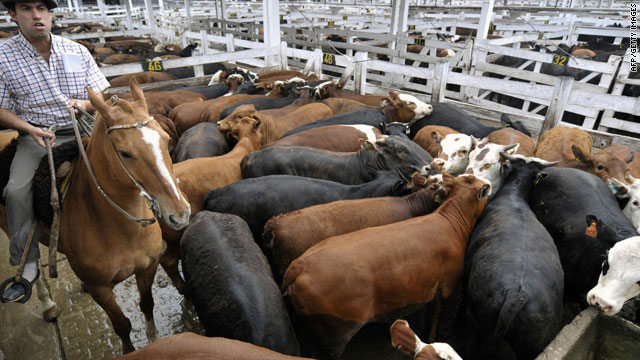THE SUPREME COURT GIVETH AND THE SUPREME COURT CLARIFIETH?
By admin on May 17, 2011
Eileen Millett is Counsel to the law firm of Epstein Becker & Green, P.C. where she represents clients on environmental matters, including solid and hazardous waste and the Clean Water Act, and counsels clients on general regulatory compliance questions, including issues related to toxic waste and water quality, permitting, emerging obligations under impending climate regulations and other federal, state, and local environmental statutes and regulations. Ms. Millett previously served as Assistant Counsel with the Hazardous Waste Task Force at NYDEC and as General Counsel to  the Interstate Environmental Commission, a tri-state water and air quality enforcement authority, where she conducted and managed litigation to control and abate water pollution and ensure adequate water and sewer infrastructure. She teaches environmental law at the Syracuse University College of Law.
the Interstate Environmental Commission, a tri-state water and air quality enforcement authority, where she conducted and managed litigation to control and abate water pollution and ensure adequate water and sewer infrastructure. She teaches environmental law at the Syracuse University College of Law.
Is the EPA over regulating and hurting business? Has EPA lagged behind in regulating Greenhouse Gases? The right answer depends on who you ask. But in deciding American Electric Power v. Connecticut the United States Supreme Court may indeed transform the way we produce and obtain energy. The case concerns the right of states and private parties to sue electric utilities under public nuisance theory for contributing to global warming. The United States Supreme Court will be asked to consider whether the plaintiffs have standing to bring the case, or whether the case presents a non-justiciable political question. In ordinary parlance, on standing — is there a connection between the utilities emissions’ and the injuries alleged, or does the causal chain depend on independent actions of others, and will the remedy sought, by itself, slow or reduce global warming; on political question —is the legislature and the Executive branches doing their jobs in a such a way that the Constitution envisions, making judicial intervention inappropriate. Said another way should we be about the business of sanctioning judicially engineered solutions to caps.
On April 19, 2011 in an expanded argument before only eight judges,with Justice Sotomayer recusing herself, six states, New York City and three private land trusts, sought an injunction in the form of an order to compel the reduction of carbon dioxide emissions and then to compel the reduction of those emissions from six major power producers, who they claimed, were the five largest emitters of carbon dioxide in the United States.
By agreeing to take this case the U.S. Supreme Court is sending a strong signal that they will likely overrule this greenhouse gas public nuisance case, since they ignored the U.S. Solicitor General, who urged the Court to vacate the circuit decision, remand the case to the district court and to take note of the administration’s push to regulate. All this fuss, because states and private parties believe that power companies are creating a public nuisance by emitting greenhouse gases (GHGs) that contribute to global warming. Some states clearly feel that tracking and reporting requirements imposed by EPA do not go far enough, and what better time than now to place caps on emissions and reduce them. Proponents focused on reducing global warming mounted a multi-prong strategy to strike at the administration, Congress and the courts. The administration has indeed made efforts, but a change in the political climate, has diminished what was once a top priority. The House passed a bill that would have established a cap and trade program, but no law was enacted as the Senate could not agree on a proposal. EPA did enact some regulation, but obviously not enough to mollify the states; EPA’s regulation requires monitoring, reporting and registering, after which EPA will release that information to the public and enable us to see who indeed, are the largest emitters of carbon dioxide. These requirements will culminate in a national database and will enable EPA to establish a baseline. The question pending before the court is whether it is appropriate for the courts to step in.
The District Court felt that the courts were not the appropriate forum. The Southern District Court of New York dismissed states and non-state plaintiffs (New York City and the private land trusts) complaint, holding that the plaintiffs’ claims would require the court to engage in the sort of balancing of competing public policy concerns that are the province of Congress and the President, and therefore presented a non-justiciable political question. On appeal, a two-judge panel of the Second Circuit (the panel originally included Judge Sonia Sotomayor, who was elevated to the Supreme Court during the pendency of the case) vacated the district court’s dismissal and remanded the matter. The Second Circuit pointed to the lack of a detailed legislative or executive branch policy as evidence that courts could adjudicate such cases without interfering with the prerogatives of the political branches. Moreover, the court held that the obvious political ramifications of any decision that a court might render in the case did not necessarily transform the issue into a “political question.” The appellate court held that both the states and non-state plaintiffs could assert public nuisance. In particular, the non-state plaintiffs could assert such claims because of the widespread, interstate nature of the harm alleged. Finally, the Circuit held that the plaintiffs’ claims were not displaced by the Clean Air Act. Walking a fine land between the Supreme Court decision in Massachusetts v. Environmental Protection Agency, 549 U.S. 497(2007), which held that EPA has the authority under the Clean Air Act to regulate carbon dioxide as an air pollutant, and the principle that federal common law is displaced when Congress has spoken directly to a particular issue, the appellate court held that at least until EPA takes some specific regulatory action — beyond its proposed (but not final finding that GHGs endanger public health and welfare) —the statute does not regulate greenhouse gas emissions, or does not regulate such emissions from stationary sources. The day after the Second Circuit issued its opinion, EPA promulgated its Final Mandatory Reporting of Greenhouse Gas Rule.
Before the Supreme Court ruling in Massachusetts v. Environmental Protection Agency, EPA had insisted that Congress had not given it the authority to deal with global warming, and EPA had cast doubt on the connection between GHGs and global warming, however, the Supreme Court ruling in case of Massachusetts v. Environmental Protection Agency, and granting certiorari in American Electric Power v. Connecticut demonstrates that the court is very willing to weigh in on climate change, or at a minimum provide some direction on the appropriate vehicle for such decision making.
The Supreme Court has for decades recognized a federal common law nuisance right, but has said that if Congress passes specific legislation that seeks to protect the public health and safety, the courts may and probably will have to allow those remedies to work in place of court crafted mandates. The states are seeking a policy outcome that the administration, Congress and EPA have not been willing to adopt. The outcome of American Electric Power v. Connecticut will have implications for two other common law public nuisance cases grounded in common law tort claims and alleging damage from climate change. Comer v. Murphy Oil, USA, 609 F.3d 1049 (5th Cir. 2010), and Native Village of Kivalina v. ExxonMobil Corp. 663 F.Supp.2d 863 (N.D. Cal. 2009).
The tone and tenor of the questioning a couple of weeks ago suggests that the court may well rule that EPA’s regulations of GHGs leaves no room for federal common law nuisance, which would invalidate any attempts to use federal common law nuisance to challenge GHG emissions, which leaves state common law nuisance, the CAA, amending the CAA and EPA regulating. Given that regulations are subject to ongoing legal challenges, climate change law may be uncertain for some time to come. Some have gone so far as to say that the CAA was not designed for the complexities of climate change. If you agree that the current vehicles available to us are inadequate to the task, we could be looking toward new legislation that will require attorneys to gear up and become knowledgeable at this evolving area of law so critically important to our energy needs.
Note: in May 2010, the EPA passed a rule to control greenhouse-gas emissions from light duty vehicles, and on January 2, the agency began to force power plants, oil refineries and other major emitters of greenhouse gases to obtain permits when making major modifications to their facilities or building new ones.


 If Theodore J. Lowi, the John L. Senior Professor of American Institutions, teaching in the Government Department at Cornell University, one day decides to again update his classic study of American Government,
If Theodore J. Lowi, the John L. Senior Professor of American Institutions, teaching in the Government Department at Cornell University, one day decides to again update his classic study of American Government,  Two wonderfully researched “must” reads for a better understanding of the debate over climate change are
Two wonderfully researched “must” reads for a better understanding of the debate over climate change are  CNN
CNN
 Two electrifying Circuit Court of Appeals cases handed down in 2009 may set the stage for climate change litigation in the years to come. The decisions are Connecticut v. American Electric Power Co., et al., 582 F.3d 309 (2d Cir. 2009) and
Two electrifying Circuit Court of Appeals cases handed down in 2009 may set the stage for climate change litigation in the years to come. The decisions are Connecticut v. American Electric Power Co., et al., 582 F.3d 309 (2d Cir. 2009) and